On Nov. 6, Maine voters will make history by using ranked-choice voting for the first time in a general election to rank their choices for U.S. Senate and House of Representatives.
In the race for U.S. Senate, you will have the opportunity to rank your first, second, and third choices among the candidates, independent Sen. Angus King, Democrat Zak Ringelstein, and Republican Eric Brakey.
In the races for the House, voters in Maine’s 1st District will rank their choices of Democrat Rep. Chellie Pingree, independent Marty Grohman, and Republican Mark Holbrook in order of individual preference, while voters in Maine’s 2nd District race will rank four candidates, Republican Rep. Bruce Poliquin, Democrat Jared Golden, and indepedents Tiffany Bond and Will Hoar, from favorite to least favorite.
Noticeably missing is the four-way general election for governor. Despite the success of two ranked-choice voting referenda, a majority of state lawmakers failed to follow through on their stated intention to send an constitutional amendment to voters for majority ratification. That would have expanded ranked-choice voting for use in this year’s governor’s race.
With ranked-choice voting, you have the freedom to vote for the candidate you like the best without worrying that you will help to elect the candidate you like the least. You can vote for someone again, and not against someone. You can vote your hopes, and not your fears.
I know the positive difference that ranked-choice voting makes in campaigns because I lived it as a candidate in the Democratic primary for governor.
Early polling in that race with seven contenders showed me registering support in the low single digits. I was not a traditional candidate. I had never held elected office before and my name recognition was quite low at the beginning. But, because of ranked-choice voting, I was never labeled as a “spoiler,” nor did voters discount me. No voter had to contemplate the dilemma of voting for me when they thought that I was the best candidate, feeling instead they had to cast their vote for one of the two leading candidates based on polling and press reports.
Among the seven candidates in that primary, there was a colleague whose values I most shared. Instead of going negative to take votes away from one another, Mark Eves and I cross-endorsed one another — me as his second choice, and him as my second choice. That was a fundamentally different way of campaigning. It was more positive, and less negative. Voters loved it.
As a “non-traditional” candidate, I offered a perspective, background, ideas and enthusiasm that has been underrepresented in the past with the old voting system. With ranked-choice voting, I could run and not be dismissed or sidelined. With ranked-choice voting my place was at table alongside an attorney general, former speaker of the House, and other traditional political and civic figures. I gave voice and hope to tens of thousands of voters who felt like they hadn’t had one before or who never before felt fully heard, and ultimately, we catapulted from near last-place to third-place.
Ranked-choice voting opens up our democracy system to more candidates. Ideas and proposals become the bedrock of the elections. When everyone — or at least more than two people — in an election have the potential to win, people tend to listen more to their ideas. They become a serious contender, their ideas get wider exposure and consideration, and sometimes those ideas are adopted by other candidates. That happened in my race.
There were 57 public forums in every corner of this state in the Democrtic primary. This required us to meet and engage with people at the local level. Each of us garnered supporters and created incredible networks of energized volunteers statewide. We talked to as many people as we could, even voters whom we knew liked another candidate better. Each of us wanted to be their second choice if we couldn’t be their first because they, too, were critical to our chances. Like a stone in the water, the ripples of engagement spread to people who often don’t bother to vote in an election and they become active participants. In our ranked-choice voting primary that translated to higher turnout because people could now vote for their favorite candidate without having to do any mental calculus about “who could win.”
How many times do we hear people say, “I love (insert candidate name here), but they don’t stand a chance of winning. I can’t waste my vote on them.” That is now gone in the primaries and in the general election for U.S. Senate and House of Representatives.
Here’s the other really interesting thing about ranked-choice voting that serves policymakers and ultimately the voters: Once all the votes are counted and the rounds of automatic runoff are complete, we now have a round-by-round analysis that reveals more authentic representation of what voters people truly believe and the issues that matter to them based on how they ranked the candidates and how they cast their vote in each round of tabulation to reach a majority winner.
As with any new system there is much to be learned by candidates, parties, the media, special interests, election administrators and voters. There will be elections in which my favorite candidate benefits from ranked-choice voting, and elections in which my favorite candidate can’t get to a majority. But, all in all, I am enthusiastic about this change and I look forward to ranking my choices this November and in the future.
Be sure to rank your vote where you can on Nov. 6. Let’s get on it. Democracy matters.
Betsy Sweet, of Hallowell, a longtime activist and lobbyist, finished third in the Democratic primary for governor.
Send questions/comments to the editors.


